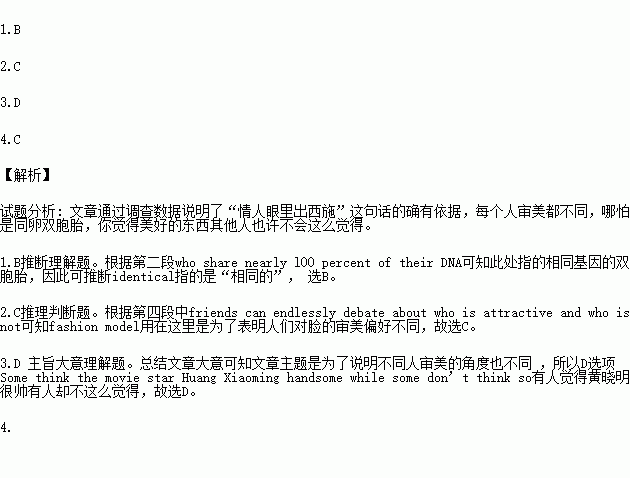题目内容
We all know the saying“beauty is in the eye of the beholder”, and the fact that there are a whole lot of strange—looking people out there happily loved up would suggest that it’s true.But scientists have now performed the biggest test so far,analyzing the preferences of more than 35,000 people,and have shown that we really do all have a unique “type”.
In fact,the study showed that even identical twins,who share nearly l00 percent of their DNA, aren’t attracted to the same people,suggesting that it’s our experiences,more than our genes,that determine whether we find someone hot or not.
“We estimate that an individual’s aesthetic(审美的)preferences for faces agree about 50 percent,and disagree about 50 percent,with others,’’explained Laura Germine from Harvard University,and Jeremy Wilmer of Wellesley College,lead researchers of the project.
“This fits with the phenomenon that on one hand,fashion models can make a fortune with their good looks,while on the other hand,friends can endlessly debate about who is attractive and who is not,”they added.“Of course,there are some things that people seem to find pretty much universally pleasant to look at,eg,most people prefer faces that are symmetric(对称的).”But after analyzing the facial preferences of more than 35,000 volunteers, the researchers found that,it was experiences that seemed to be what shape the “eye of the beholder”.And those experiences are highly specific to each individual.
So in other words,it’s not your family,where you grew up,or how much money your parents make that shape who you’re attracted to,it’s things like the magazines you read, the social activities you’ve take part in,and even your first boyfriend or girlfriend,that determine these preferences.

1.What does the underlined word “identical” in Para 2 mean?
A.unique B.same
C.distinguishing D.considerate
2.Why does the writer talk about the “fashion model”?
A.To tell us they own beautiful faces which help them earn money.
B.To emphasize they have symmetric faces which people widely enjoy.
C.To show people’s preference for faces partly agree and disagree.
D.To explain the role genes play in people’s preference.
3.Which of the following statements agrees with the theme of the passage?
A.Symmetric faces look beautiful in eastern culture but not in western culture.
B.The more beautiful a person looks,the more likely he is to get a success.
C.A person’s aesthetic preferences for beauty will remain the same in the future.
D.Some think the movie star Huang Xiaoming handsome while some don’t think so.
4.What is the title of the passage?
A.Gene preference or social preference?
B.Difficult to meet every taste.
C.Beauty is in the eye of beholder.
D.Love me,love my dog?
写作
假设你是李华, 你的加拿大朋友Bob 给你发了一封电子邮件,想了解一下中国高中生对于大学的选择意向,于是你在班里进行了一次调查。请根据下表的信息,给Bob 回复一封电子邮件,告诉他调查结果,并说明原因。
选择意向和比例 | 原因 |
省内大学25﹪ | 录取机会大;生活习惯相似 |
省外大学70﹪ | 培养独立性;可选学校多 |
国外大学5﹪ | 了解外国文化;有助于学外语 |
注意: 1.词数100左右;
2.电子邮件的开头和结尾已给出,不计入总词数。
Dear Bob,
Last week I did a survey among the students in my class on what university they want to choose. ______________________________________________________________
______________________________________________________________
______________________________________________________________
Yours,
Li Hua


 getting into the Christ
getting into the Christ mas spirit.
mas spirit.